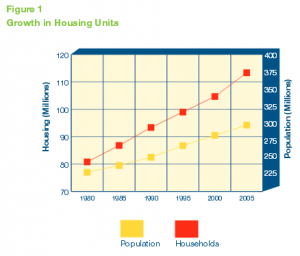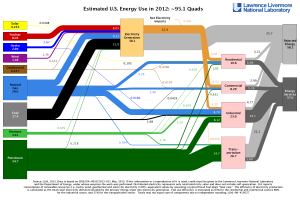Over the past few years, one of the biggest movements has been the push for net zero buildings. Net zero buildings (NZB), or net zero energy buildings, are those that put the same amount of energy back into the grid as they consume. A net zero building does not produce a carbon footprint as it does not produce any greenhouse gases. Net zero buildings are most often achieved through a combination of energy efficiency and renewable measures. In 10 to 15 years, some experts believe the U.S. will have a strong system in place to produce net zero buildings for most new construction in the residential and commercial sector. Achieving net zero building construction is critical for the U.S. to reduce its energy consumption and waste, which has seen virtually no improvement in the past decade. In this article, we’ll discuss U.S. energy consumption levels, how much we waste, the importance of the Net Zero Energy Commercial Buildings Initiative, and what measures can be taken.
Building Energy Consumption in the U.S
According to the United States Green Building Council (USGBC), U.S. buildings emit 39% of total U.S. carbon dioxide (CO2), the main gas associated with climate change. Furthermore, according to the U.S. Energy Information Administration (EIA), residential and commercial buildings consume 41% of total U.S. energy. This energy consumption is a growing concern, as the numbers over the past decade haven’t shown any significant decline. In 2006, the Center for Climate and Energy Solutions estimated buildings consume 39% of total U.S. energy. Several years later in 2014, Whole Building Design Guide, a program of the National Institute of Building Sciences, estimated buildings consumed 39%. While the numbers fluctuated during those 8 years, we still didn’t see any real decline up to 2014, and 2015 is actually seeing an increase in total building energy consumption.
Why? Population. As population rises, more houses and businesses are built, which contributes to higher energy demands. A 2008 study by the U.S. Department of Energy shows U.S. population grew 30% from 1980 to 2005. In 2005, U.S. population was approximately 300 million. In 2014, those numbers rose another 18.9 million.

Historically Wasteful
Here’s another hurtful truth: we waste more energy than we save. According to the Lawrence Livermore National Laboratory, a federal research facility in Livermore, California, the U.S. wastes 61% of its energy: we are only 31% efficient. Even more disturbing is American physicist and economist Robert Ayres’s assertion that the U.S. is actually only 14% efficient, which he postulates in his 2010 book Crossing the Energy Divide

“The best hope, experts agree, is a huge increase in energy efficiency,” reports The Economist. “. . . Only one-third of the available energy-saving opportunities with a cost-effective payback period are taken up.” These are often due to barriers such as split-incentives, inertia, and most commonly a general lack of understanding of energy efficiency and energy efficiency programs. If everyone starts paying attention to these shocking data and starts playing their part, energy efficiency, renewable energy, and net zero building goals have a real chance to cut down on our energy consumption and waste.
The Importance of Net Zero Buildings
A major breakthrough in the sustainability movement came with the passing of the Energy Independence and Security Act of 2007 (EISA 2007). The purpose of the act is to increase the production of renewable energy and improve energy efficiency across the United States. Part of the act “. . . authorizes the Net-Zero Energy Commercial Buildings Initiative to support the goal of net zero energy for all new commercial buildings by 2030, and specifies a zero-energy target for 50% of U.S. commercial buildings by 2040 and net zero for all U.S. commercial buildings by 2050.” With that timeframe in mind, many experts believe we’re on track to see many new buildings as net zero buildings in only 10 to 15 years. From a sustainability and economic point of view, it’s very important to improve the energy efficiency of both existing and new buildings because “. . . half the buildings standing today will still be there in 2050. So big efficiency gains can come only from making existing buildings less wasteful.”
What Measures Are Necessary to Produce a Net Zero Building?
Most sustainable residential and commercial buildings are still connected to the grid, despite common misconceptions that they are not. When the amount of energy gained from renewable sources (solar panels, wind farms, etc.) depletes, the building will be powered by the grid. This is why energy efficiency still plays an integral role. As such, achieving net zero buildings requires a combination of energy efficiency and renewable energy. According to a 2014 article by Whole Building Design Guide:
“minimizing the energy use through efficient building design should be a fundamental design criterion and the highest priority of all NZEB projects. Energy efficiency is generally the most cost-effective strategy with the highest return on investment, and maximizing efficiency opportunities before developing renewable energy plans will minimize the cost of the renewable energy projects needed.”
The same article espouses many of the same energy efficiency measures we here at Prism recommended wholeheartedly. These measures include some of the more routine upgrades, including:
- Installing more energy efficient lighting systems, such as high-efficiency fluorescent lighting or LEDs
- Installing lighting controls to optimize electricity savings through your lighting systems
More comprehensive measures include, but are not limited to:
- Whole building analysis
- Energy management systems
- Energy modeling programs
- Building commissioning
- Insulation and weatherization
- Installing economizers, variable frequency drives, and controls to for mechanical systems
Benefits of a Net Zero Building
As we’ve discussed throughout the article, there are several advantages to net zero buildings: CO2 reductions, virtually no energy waste, and energy bill savings. A net zero building will consume as much energy as it produces, which allows it to have virtually no carbon footprint. This is great for the environment and it helps us lower our dependence on the grid. However, in order for the idea of net zero buildings to really gain traction, it is imperative that people take action and realize the significance of energy efficiency and renewable measures so we can break free of our current energy stalemate dilemma.




